View in other NatureServe Network Field Guides
NatureServe
Montana
Utah
Wyoming
Idaho
Wisconsin
British Columbia
South Carolina
Yukon
California
New York
Bitterroot Mountainsnail - Oreohelix amariradix
Other Names:
Pyramidula strigosa
General Description
A medium-sized shell, adults to about 16 mm diameter and 9 mm in height, neonates 2.5 to 3.4 mm diameter; somewhat flattened heliciform with up to 5 1/3 whorls in adults, 2 to 2 1/3 whorls in neonates; the last whorl of adults descends in front. Whorls somewhat rough textured with irregular axial riblets and striae. Umbilicus narrow (contained about 4 times in diameter) and deep, aperture rather strongly oblique or ovate and not thickened, periphery sharply angular though more rounded nearer the aperture. Shell opaque and chalky, color is brownish-gray (sun-bleached shells to pearly white), with a reddish-brown spiral band above and below the periphery, although number of bands may be variable. Smaller shells may have a brownish cuticle that is lost in larger individuals; soft parts of live animals not described (Hendricks 2012; Burke 2013). Internal anatomy described by Fairbanks (1980).
Phenology
Active in wet and cool weather; otherwise not described.
Diagnostic Characteristics
In the field best identified based upon a combination of size, form, location and habitat. A combination of shell shape (flattened heliciform or flattened conic), size, opaque shell color (especially chalky white when dead) with a few bands, absence of reflected lip, and absence of teeth in the aperture distinguishes this from other Montana land snails except Oreohelix (Hendricks 2003). Other species of Oreohelix in Montana tend to be larger in height and diameter (and less flattened) or else occur in different habitats with non-overlapping ranges, and are smaller (Hendricks 2012; Burke 2013).
Species Range
Montana Range
Range Descriptions
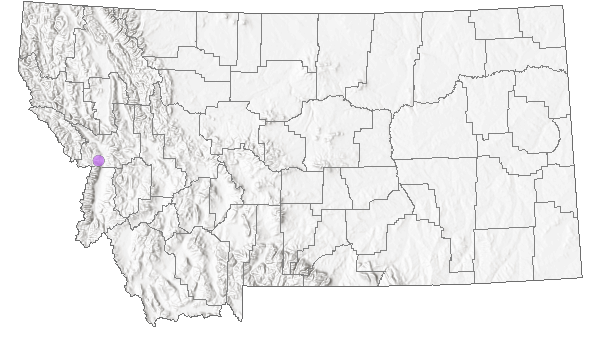
 Native
Native
Range Comments
Montana endemic: original description is based on specimens collected in 1897 and 1902 by Morton J. Elrod in the Lolo Creek drainage of the Bitterroot Mountains. In Montana, eight records from at least three sites, all west of the Continental Divide in Missoula County, and all near Fort Fizzle. Elevation range is 1052 to 1399 m (3450 to 4590 ft). Sometimes moderately abundant; as many as 21 (live and shells) were seen at one site in Missoula County in late May. Some sites have experienced intense fire since 2000 and need to be revisited to determine if viable populations still exist (Hendricks 2012; Burke 2013).
Observations in Montana Natural Heritage Program Database
Number of Observations: 8
(Click on the following maps and charts to see full sized version)
Map Help and Descriptions
Relative Density

Recency
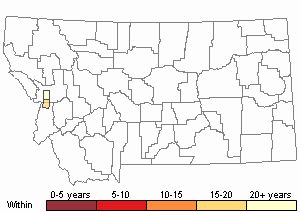
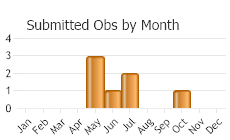
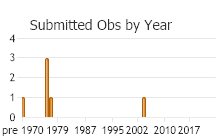
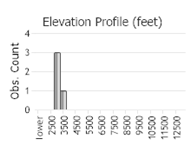 (Observations spanning multiple months or years are excluded from time charts)
(Observations spanning multiple months or years are excluded from time charts)
Migration
Non-migratory.
Habitat
Grassy south-facing slopes. Tree canopy, where present, includes scattered ponderosa pine. Understory cover includes scattered serviceberry, ninebark, and bunch grasses. Live animals present mostly in small talus slides under rocks and in duff or soil accumulations (Fairbanks 1980; Hendricks 2013).
Food Habits
Not described.
Reproductive Characteristics
Hermaphroditic (Fairbanks 1980), otherwise not described.
Stewardship Responsibility
Threats or Limiting Factors
Habitat occupied by Oreohelix amariradix is threatened by logging, grazing, weed control, highway development, home development, and fire. The impact of fire retardant on this and other terrestrial mollusks in not known. Little is known about this species, including its susceptibility to disturbance (Frest and Johannes 1995; Hendricks 2003).
References
- Literature Cited AboveLegend:
 View Online Publication
View Online Publication Burke, T. E. 2013. Land snails and slugs of the Pacific Northwest. Corvallis, OR: Oregon State University Press. 344 p.
Burke, T. E. 2013. Land snails and slugs of the Pacific Northwest. Corvallis, OR: Oregon State University Press. 344 p. Fairbanks, H.L. 1980. Morphological notes on Oreohelix amariradix Pilsbry, 1934 (Pulmonata: Oreohelicidae). The Nautilus 94(1).
Fairbanks, H.L. 1980. Morphological notes on Oreohelix amariradix Pilsbry, 1934 (Pulmonata: Oreohelicidae). The Nautilus 94(1). Frest, T.J. and E.J. Johannes. 1995. Interior Columbia Basin mollusk species of special concern. Final report to the Interior Columbia Basin Ecosystem Management Project, Walla Walla, WA. Contract #43-0E00-4-9112. 274 pp. plus appendices.
Frest, T.J. and E.J. Johannes. 1995. Interior Columbia Basin mollusk species of special concern. Final report to the Interior Columbia Basin Ecosystem Management Project, Walla Walla, WA. Contract #43-0E00-4-9112. 274 pp. plus appendices. Hendricks, P. 2003. Status and conservation management of terrestrial mollusks of special concern in Montana. Unpublished report prepared for the U.S. Forest Service. Montana Natural Heritage Program, Helena, Montana. 67 pp. + appendices.
Hendricks, P. 2003. Status and conservation management of terrestrial mollusks of special concern in Montana. Unpublished report prepared for the U.S. Forest Service. Montana Natural Heritage Program, Helena, Montana. 67 pp. + appendices. Hendricks, P. 2012. A Guide to the Land Snails and Slugs of Montana. A report to the U.S. Forest Service - Region 1. Montana Natural Heritage Program, Helena, MT. vii + 187 pp. plus appendices.
Hendricks, P. 2012. A Guide to the Land Snails and Slugs of Montana. A report to the U.S. Forest Service - Region 1. Montana Natural Heritage Program, Helena, MT. vii + 187 pp. plus appendices.
- Additional ReferencesLegend:
 View Online Publication
View Online Publication
Do you know of a citation we're missing? Elrod, M.J. 1902. A biological reconnoissance in the vicinity of Flathead Lake. Bulletin of the University of Montana Number, Biological Series 10(3):89-182.
Elrod, M.J. 1902. A biological reconnoissance in the vicinity of Flathead Lake. Bulletin of the University of Montana Number, Biological Series 10(3):89-182. Henderson, J. 1936. Mollusca of Colorado, Utah, Montana, Idaho, and Wyoming, supplement. University of Colorado Studies 23(2): 81-145.
Henderson, J. 1936. Mollusca of Colorado, Utah, Montana, Idaho, and Wyoming, supplement. University of Colorado Studies 23(2): 81-145. Linscott, T.M., K. Weaver, V. Morales, and C.E. Parent. 2020. Assessing species number and genetic diversity of the Mountainsnails (Oreohelicidae). Conservation Genetics 21:971-985.
Linscott, T.M., K. Weaver, V. Morales, and C.E. Parent. 2020. Assessing species number and genetic diversity of the Mountainsnails (Oreohelicidae). Conservation Genetics 21:971-985. Pilsbry, H.A. 1934. Notes on the anatomy of Oreohelix, III with descriptions of new species and subspecies. Proceedings of the Academy of Natural Sciences of Philadelphia 85:383-410
Pilsbry, H.A. 1934. Notes on the anatomy of Oreohelix, III with descriptions of new species and subspecies. Proceedings of the Academy of Natural Sciences of Philadelphia 85:383-410 Pilsbry, H.A. 1939. Land Mollusca of North America (North of Mexico), Volume 1, Part 1. Monograph of the Academy of Natural Sciences of Philadelphia Monograph Number 3 (1): 1-573.
Pilsbry, H.A. 1939. Land Mollusca of North America (North of Mexico), Volume 1, Part 1. Monograph of the Academy of Natural Sciences of Philadelphia Monograph Number 3 (1): 1-573.
- Web Search Engines for Articles on "Bitterroot Mountainsnail"
- Additional Sources of Information Related to "Snails / Slugs"





